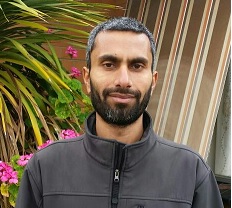Hello and a warm welcome to Wireless Pi by Qasim Chaudhari.

For any topic, fundamentals are so important to me that I came up with the following quote (recall "there is always room at the top").
There is always room at the bottom.
This is why I have written everything here from the ground up, even including Artificial Intelligence, where the complex numbers originated from, significance of I/Q signals, Fourier Transform and many other topics in digital signal processing as well as algorithm development for wireless communication systems. All these concepts are presented with a perspective you would have never read before.
Here is some background on how this website started.
Background
One day at work, my friend Azam gave me Digital Communications – A Discrete-Time Approach written by Michael Rice. Reading a few pages of his book ignited a spark in my heart and made me wonder how could something be so beautiful and coherent. It was like poetry. The preface introduced me to Fred Harris and his book Multirate Signal Processing for Communication Systems.
I read them multiple times and always found myself asking why these concepts seem complicated when they could be explained in a much easier manner. Since I had this coherent picture of the art of DSP applied to the science of wireless communications in my mind, I started writing about these topics myself. The result was the creation of the following resources:
During the past decade, I have worked in different organizations on individual projects. This helped me in making new connections between seemingly disparate concepts and distinguishing the forest from the trees. It was surprising to discover that more knowledge actually takes less space in our minds. In words of Richard Feynman in The Pleasure of Finding Things Out:
"In the case of the chess game, the rules become more complicated as you go along, but in the physics, when you discover new things, it looks more simple. It appears on the whole to be more complicated, because we learn about a greater experience, that is, we learn about more particles and new things, and so the laws look complicated again. But if you realize that all the time what’s kind of wonderful is that, as we expand our experience into wilder and wilder regions of experience, every once in a while we have these integrations in which everything is pulled together in a unification, which turns out to be simpler than it looked before."
The one-page summary of the crux of Rx algorithms design I offer as a bonus in my eBooks is exactly this simplification of major concepts in wireless and SDR.
The Big Picture
The study of SDRs has also taught me how to see the big picture of life. The following points capture the core ideas.
- The power of DSP:
- Everything that moves or jiggles in the universe generates signals
- All practical signals can be represented by a sequence of numbers
- All sequences of numbers can be manipulated by algorithms.
- If mathematics is the language of the universe, then the algorithms are the songs of that language!
- An untold secret about SDRs:
- RF circuits and antenna design are bound by the laws of physics
- But with samples in the machine, the only limit is your own imagination
- With a little passion and ingenuity, the DSP world will look like a playground!
Biography
I obtained a PhD in Electrical Engineering from Texas A&M University and worked at various organizations including Qualcomm, Renzym, Center for Energy Efficient Telecommunications and RMIT University, Australia. My expertise lies in the areas of wireless communications, Software Defined Radio (SDR) and Digital Signal Processing (DSP). I have developed and implemented DSP algorithms for real world demonstrations of many wireless systems such as a MIMO-OFDM testbed, low-SNR receivers and phase of arrival based localization. You can contact me by clicking here.
Stay in touch
On this website, I write about DSP, SDR and wireless communications in general. I regularly publish new articles on signal processing techniques and baseband algorithms for PHY design of digital wireless systems. To receive them, you can subscribe via email below.